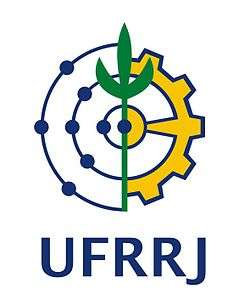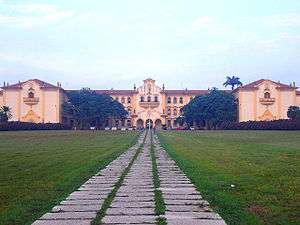Federal Rural University of Rio de Janeiro
The Federal Rural University of Rio de Janeiro (Portuguese: Universidade Federal Rural do Rio de Janeiro, UFRRJ) is a centenary public university located in Seropédica in the State of Rio de Janeiro in Brazil. It possesses the largest campus among Latin American universities, and is known for being the first university to have agriculture related courses in Brazil.
Universidade Federal Rural do Rio de Janeiro | |
 | |
Other names | UFRRJ |
|---|---|
| Type | Public university system, Federal |
| Established | October 20, 1910 |
| Endowment | R$ 352.733.407,24 (2010) |
| Chancellor | Ricardo Motta Miranda |
| Vice-Chancellor | Ana Maria Dantas Soares |
Administrative staff | 1086 |
| Students | 11,932 |
| Location | , State of Rio de Janeiro , |
| Campus | Seropédica, Nova Iguaçu, Três Rios |
| Colors | Yellow - Green |
| Website | http://www.ufrrj.br |
History
Founded in October 20, 1910, by then president of the republic Nilo Peçanha, the College of Agriculture and Veterinary Medicine (ESAMV) laid the foundations of agricultural education in Brazil. The ESAMV, however, only began operating in 1913 and ended in 1934. In its place emerged three distinct institutions: the National School of Agriculture (ENA), National School of Veterinary Medicine (ENV) and the National School of Chemistry (which was incorporated in 1937 by the University of Brazil, today Federal University of Rio de Janeiro). These institutions have been crucial to overcoming the fragmentary and differentiated from existing agricultural and veterinary education throughout the nineteenth century and to create an academic reference space. In January 1944, the Rural University is established as an organ of the National Centre for Agronomic Research and Teaching (PNES) and incorporates the ENA and the Environment.
The creation of ESAMV thus represents the origin of the Rural University of Brazil, today the Federal Rural University of Rio de Janeiro.
This university has a college for high school course with technical integrated, like agriculture, hosting and environment called CTUR. It's located inside the campus of the university.
Undergraduate courses


- Administration
- Architecture, Urbanism
- Accountancy
- Computer Science
- Information Systems
- Agronomy
- Agricultural and Environmental Engineering
- Engineering Surveying and Cartography
- Forest Engineering
- Food engineering
- Materials engineering
- Chemical Engineering
- Geology
- Mathematics
- Mathematics applied to computer
- Animal Science
- Chemistry
- Agricultural Sciences
- Biological Sciences
- Home Economics
- Pharmacy
- Environmental Management
- Veterinary Medicine
- Psychology
- Economics
- Social sciences
- Social communication, Journalism
- Law
- Art
- Physical education
- Philosophy
- Geography
- History
- Linguistics
- Pedagogy
- International relations
- Tourism
- Hotel Management[1]